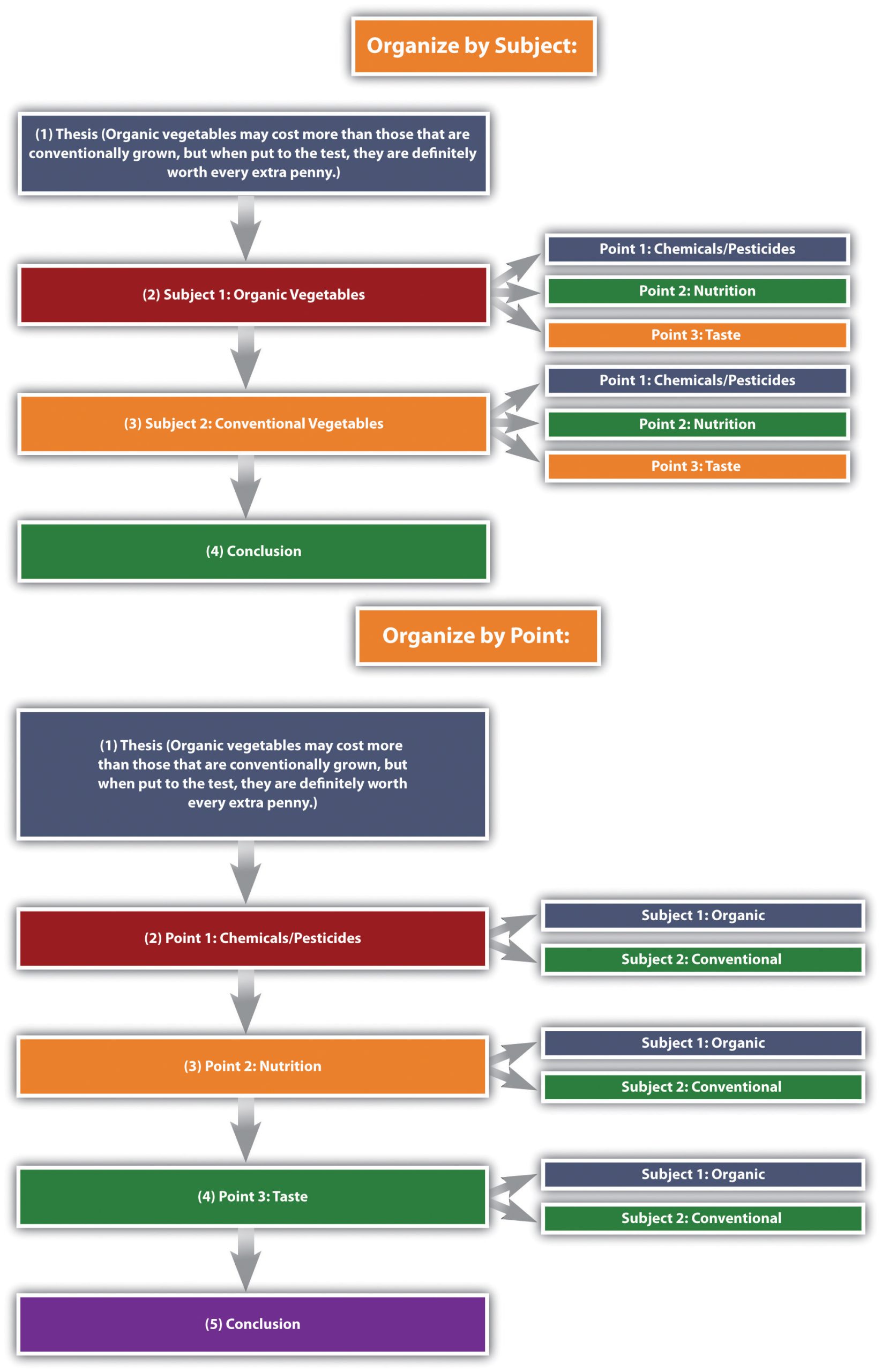Chapter 19: Comparison and Contrast
The textbook Successful Writing introduces the key elements of writing a comparison and contrast essay. In writing, comparison discusses elements that are similar, while contrast discusses elements that are different. A compare-and-contrast essay, then, analyzes two subjects by comparing them, contrasting them, or both. These skills are helpful in many writing situations, especially when you spend time completing textual analysis.
The key to a good compare-and-contrast essay is to choose two or more subjects that connect in a meaningful way. The purpose of conducting the comparison or contrast is not to state the obvious but to illuminate subtle differences or unexpected similarities while contemplating the meaning of the similarities or differences. For example, if you wanted to focus on contrasting two subjects you would not pick apples and oranges; rather, you might choose to compare and contrast two types of oranges or two types of apples to highlight subtle differences and the potential for each.
For example, Red Delicious apples are sweet, while Granny Smiths are tart and acidic; therefore, one type is better suited for baking and the other for eating as a snack. Drawing distinctions between elements in a similar category will increase the audience’s understanding of that category, which is the purpose of the compare-and-contrast essay.
Similarly, to focus on comparison, choose two subjects that seem at first to be unrelated. For a comparison essay, you likely would not choose two apples or two oranges because they share so many of the same properties already. Rather, you might try to compare how apples and oranges are quite similar: both are fruit, both contain fiber, etc. The more divergent the two subjects initially seem, the more interesting a comparison essay will be.
The Structure of a Comparison and Contrast Essay
Similar to other academic essays, the compare-and-contrast essay starts with a thesis that clearly introduces the two subjects that are to be compared, contrasted, or both and the reason for doing so. The thesis could lean more toward comparing, contrasting, or both. Remember, the point of comparing and contrasting is to provide useful knowledge to the reader. Take the following thesis as an example that leans more toward contrasting.
Thesis statement: Organic vegetables may cost more than those that are conventionally grown, but, when put to the test, they are definitely worth every extra penny due to fewer pesticides, superior taste, and nutritional value.
Here the thesis sets up the two subjects to be compared and contrasted (organic versus conventional vegetables), and it makes a claim about the results that might prove useful to the reader.
You may organize compare-and-contrast essays in one of the following two ways:
- According to the subjects themselves, discussing one then the other
- According to individual points, discussing each subject in relation to each point.
See Figure 19.1 “Comparison and Contrast Diagram”, which diagrams the ways to organize our organic versus conventional vegetables thesis.

The organizational structure you choose depends on the nature of the topic, your purpose, and your audience.
Given that comparison and contrast essays analyze the relationship between two subjects, it is helpful to have some phrases on hand that will cue the reader to such analysis.
| Comparison | Contrast |
|---|---|
| One Similarity | One Difference |
| Another Similarity | Another Difference |
| Both | Conversely |
| Like | In Contrast |
| Likewise | Unlike |
| Similarly | While |
| In a Similar Fashion | Whereas |
Writing a Comparison and Contrast Essay
Students are often provided with a general concept for a compare and contrast essay, so spend time reviewing your essay prompt to ensure you clearly understand the goals for your assignment. Then you will need to decide whether you want to compare seemingly disparate subjects, contrast seemingly similar subjects, or compare and contrast subjects. Once you have decided on a topic, introduce it with an engaging opening paragraph. This is your opportunity to hook your reader and introduce the significance of your essay. Your thesis should come at the end of the introduction, and it should establish the subjects you will compare, contrast, or both as well as state what can be learned from doing so.
The body of the essay can be organized in one of two ways: by subject or by individual points. The organizing strategy that you choose will depend on, as always, your audience and your purpose. You may also consider your particular approach to the subjects as well as the nature of the subjects themselves; some subjects might better lend themselves to one structure or the other. Make sure to use comparison and contrast phrases to cue the reader to the ways you are analyzing the relationship between the subjects.
After you finish analyzing the subjects, write a conclusion that summarizes the main points of the essay and reinforces your thesis.
Consider the following example of utilizing comparison and contrast in the film The Wizard of Oz.
To lend validity to the feminist perspective on The Wizard of Oz, you might compare the film to others of the same period that also show powerful women in a negative light.


Consider, for instance, how the evil queen in Walt Disney’s 1937 film Snow White and the Seven Dwarves uses her magic to achieve her desires, while Snow White, the ideal of femininity, simply waits for a man to come along and rescue her (Walt Disney Productions, 1937).
You could also underscore how a subject is influenced by cultural attitudes through contrast. For example, if you wanted to explain why a show like South Park or Family Guy has particular appeal to young people today, you might contrast these shows with coming of age television series from other periods. For instance, you could contrast an episode of South Park with an episode of Leave it to Beaver, an iconic series from the 1950s. Though the main characters, Beaver and Wally Cleaver, often get into trouble, it is never anything like the kind that Eric Cartman gets into, and, unlike Cartman, who is spoiled by his single mother, the Cleaver kids are always able to talk out their difficulties with their father who helps them to learn from their mistakes at the end of each episode. Again, the conclusions you draw from this contrast could vary. You might assert that this relationship reveals the necessity of a strong father figure, so you might suggest that the tightly controlled patriarchal family structure of the 1950s inspired rebellion and ridicule in the decades that followed, or you might come to a conclusion somewhere in between these two extremes.
Along these lines, you might also consider explaining your subject by contrasting it with how it could have been different by calling your reader’s attention to the details that were deliberately omitted. For instance, you might analyze an advertisement by revealing what it doesn’t show about the product. Advertisements for fast food restaurants usually show families sitting together, relaxed, and having a good time, but they never show how people usually eat at these places, quickly and alone. And these ads certainly do not reveal the negative effects that eating too much fast food can have on the body, such as heart disease or obesity.
Your interpretation of a subject may seem apparent to you, but your reader may see it differently and not understand how you derived your perspectives. By providing explanations, you show that you took the time to pay careful attention.
Though not everyone will agree with your point of view, most will at least respect it if they see that you derived your assertions from a close consideration of the subject and did not just rely on a gut reaction based on a brief glance. Ultimately, you will want to discuss your essay’s point of view with your instructor. Different genres and essay goals will dictate the need for a specific point of view.
Adapted from “Chapter 4” of A Guide to Perspective Analysis, 2012, used according to Creative Commons CC BY-SA 3.0 and from “Chapter 10” of Successful Writing, 2012, used according to Creative Commons CC-BY-SA 3.0

